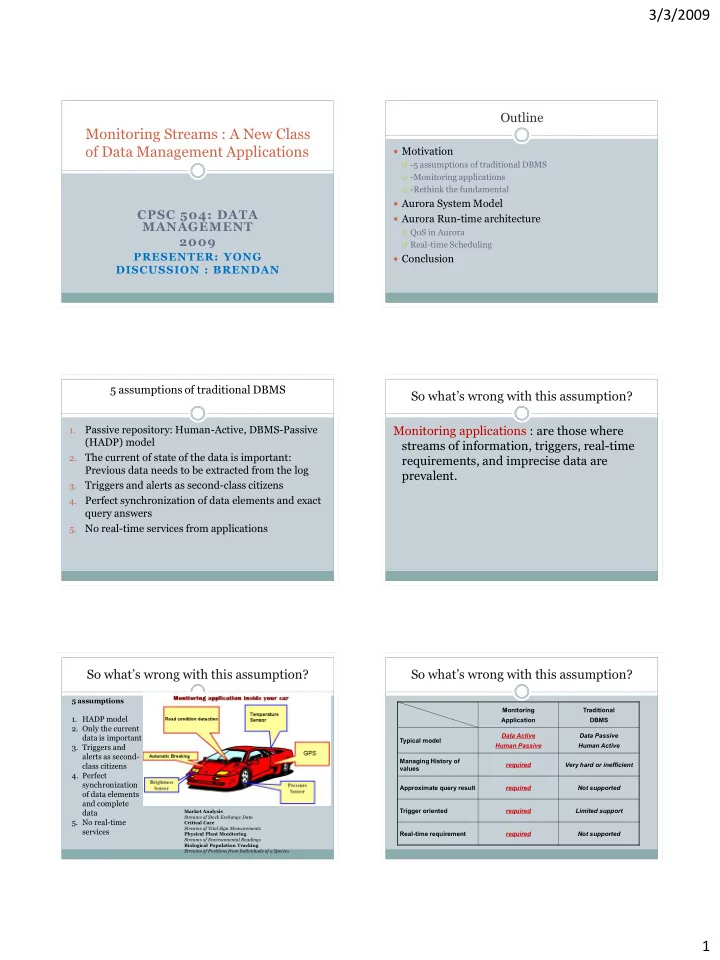

3/3/2009 Outline Monitoring Streams : A New Class of Data Management Applications Motivation -5 assumptions of traditional DBMS -Monitoring applications -Rethink the fundamental Aurora System Model CPSC 504: DATA Aurora Run-time architecture MANAGEMENT QoS in Aurora 2009 Real-time Scheduling PRESENTER: YONG Conclusion DISCUSSION : BRENDAN 5 assumptions of traditional DBMS So what’s wrong with this assumption? Passive repository: Human-Active, DBMS-Passive Monitoring applications : are those where 1. (HADP) model streams of information, triggers, real-time The current of state of the data is important: 2. requirements, and imprecise data are Previous data needs to be extracted from the log prevalent. Triggers and alerts as second-class citizens 3. 4. Perfect synchronization of data elements and exact query answers No real-time services from applications 5. So what’s wrong with this assumption? So what’s wrong with this assumption? 5 assumptions Monitoring Traditional 1. HADP model Application DBMS 2. Only the current Data Active Data Passive data is important Typical model Human Passive Human Active 3. Triggers and alerts as second- Managing History of class citizens required Very hard or inefficient values 4. Perfect synchronization Approximate query result required Not supported of data elements and complete Trigger oriented required Limited support data Market Analysis Streams of Stock Exchange Data 5. No real-time Critical Care Streams of Vital Sign Measurements services Real-time requirement required Not supported Physical Plant Monitoring Streams of Environmental Readings Biological Population Tracking Streams of Positions from Individuals of a Species 1
3/3/2009 So what’s wrong with this assumption? Aurora System Model SO! So, the solution “ Aurora” , which is designed to better support monitoring applications All 5 assumptions are problematic -Stream data for motoring applications! -Triggers -Imprecise data -Real-time requirement Aurora System Model Boxes : Operations 8 primitive operators (Box) Windowed : Operate on a set of consecutive tuples from a stream at a time. Applies function to a windows and advances the window to capture a new set of tuples. Slide : advances a window by ‘sliding’ it downstream by some no of tuples. Tumble: consecutive windows don’t have overlap Latch: maintain internal state between window. Resample : produce synthetic stream. Aurora: process incoming streams in the way defined by an Non-windowed: single tuple at a time applications (data-flow system : Aurora Network) Filter : condition Data sources (stream) : A stream in Aurora is a sequence Map : apply a function to every tuple of tuples from a given data source, and each tuple is time GroupBy : partition incoming tuples across multiple streams to groups stamped upon entry to Aurora Join : pairs tuples from input streams Boxes : performs operations on incoming stream of data Aurora Run-time architecture 3 kinds of query supported Continuous View Ad-Hoc Query 2
3/3/2009 QoS: Quality of Service QoS: Quality of Service Quality of Service (QoS) must be provided by the application administrator! The QoS monitor constantly monitors system performance and activates load shedder (ex. Drop tuples) when it is needed, that is, the system performance is degrading by data overload. Discussion Real Time Scheduling The authors state: "Asking the application Scheduling decision on QoS is not enough! administrator to specify a multidimensional QoS function seems impractical. Instead, Aurora relies Maximize overall QoS + reduce overall end to on a simpler tactic, which is much easier for humans end tuple execution costs! to deal with: for each output stream, we expect the application administrator to give Aurora a two- dimensional QoS graph based on the processing delay of output tuples produced." Does this seem But how? easier? Does it make sense to you? Conclusion Aurora Stream Query Processing System Designed for Scalability QoS-Driven Resource Management Continuous and Historical Queries Stream Storage Management Implemented Prototype www.cs.brown.edu/research/aurora/ 3
3/3/2009 Discussion Compare Aurora with distributed databases (e.g., Mariposa) and adaptive query execution systems (e.g., Eddies). These systems have to handle arbitrary data arrival rates, and don’t know in advance how much data they will need to process. How does this differ from the continuous query problem? Which techniques are common to both? 4
Recommend
More recommend